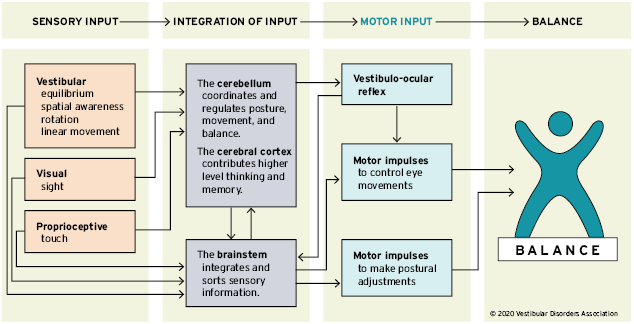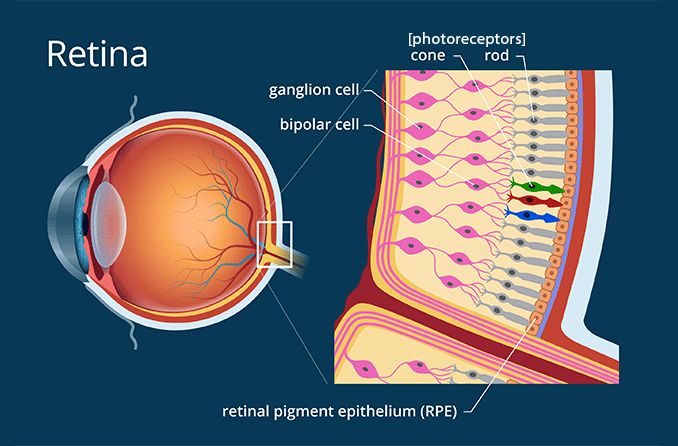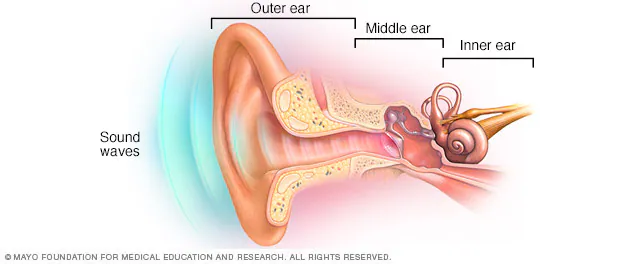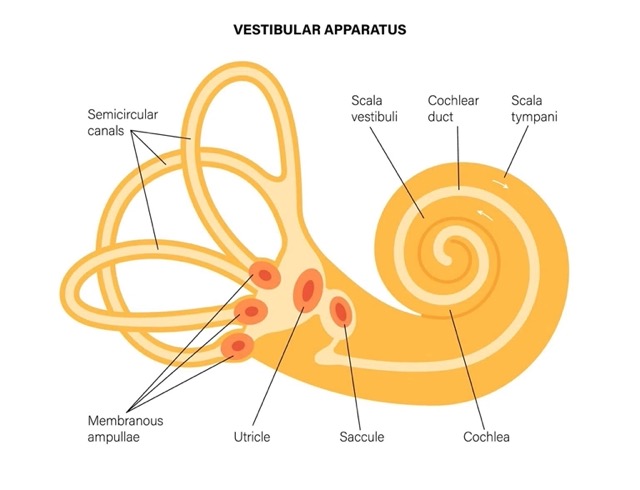Balance: How the human balance system works
Post date: 03/10/2023
What is balance?
How we maintain balance
We maintain balance by using a complex system of sensory input and motor output. The three main sensory systems involved in balance are:
The visual system
Your eyes allow you to perceive where your head and body are in connection to the world around you and to detect motion between you and your surroundings.
The proprioceptive system
Special sensors in your muscles, tendons, and joints that detect stretch or pressure help your brain determine how your feet and legs are positioned in relation to the ground and how your head is positioned in relation to your chest and shoulders.
The vestibular system
Inner ear balance organs communicate with the brain regarding your head's movements and location.

Fig: Balance is achieved and maintained by a complex set of sensorimotor control systems include: vestibular, visual, proprioceptive.
Sensory input
The brain receives input from three peripheral sources to maintain balance.
the eyes, muscles and joints, and vestibular organs.
All three of these information sources convey nerve impulses to the brain via special nerve endings known as sensory receptors.
Input from the eyes
Rods and cones are photoreceptor cells in the retina of the eye. These are responsible for converting light into electrical signals that are sent to the brain.

Rods are more numerous than cones and are responsible for vision in low light conditions. They do not mediate color vision, and have a low spatial acuity.
Cones are responsible for color vision and high spatial acuity. There are three types of cones, each sensitive to a different wavelength of light: red, green, and blue.
When light contacts the rods and cones, impulses are sent to the brain, providing visual clues indicating how a person is oriented in relation to other things. As a walker walks along a city street, for example, the surrounding buildings seem vertically aligned, and each storefront passes into and then beyond the area of peripheral vision.
The proprioceptive system - Input from the muscles and joints
Proprioceptive information from the skin, muscles, and joints involves sensory receptors that are sensitive to stretch or pressure in the surrounding tissues.
For example, increased pressure is felt in the front part of the soles of the feet when a standing person leans forward. With any movement of the legs, arms, and other body parts, sensory receptors respond by sending impulses to the brain. Along with other information, these stretch and pressure cues help our brain determine where our body is in space.
The sensory impulses originating in the neck and ankles are especially important. Proprioceptive cues from the neck indicate the direction in which the head is turned. Cues from the ankles indicate the body’s movement or sway relative to both the standing surface (floor or ground) and the quality of that surface (for example, hard, soft, slippery, or uneven).
Input from the vestibular system
The vestibular is located in the inner ear and consists of two otolith organs (the utricle and saccule) and three semicircular canals.
The otolith organs detect gravity and linear acceleration, while the semicircular canals detect rotational acceleration. When the head moves, the fluid in the otolith organs and semicircular canals shifts. This movement stimulates hair cells in the vestibular system, which send signals to the brain about the head's position and movement.
The brain uses this information to maintain balance and coordinate eye movements. For example, when you turn your head, the vestibular system sends signals to your eye muscles to keep your eyes focused on the same object. This is called the vestibulo-ocular reflex (VOR).
The vestibular system also plays a role in maintaining balance during standing, walking, and other activities. When you stand up, the vestibular system helps you to shift your weight so that you don't fall over. When you walk, the vestibular system helps you to coordinate your movements and keep your balance.
Here are some specific examples of how input from the vestibular system works in human balance:
- When you stand on one leg, your vestibular system helps you to maintain your balance by detecting small changes in your body position.
- When you walk, your vestibular system helps you to coordinate your footsteps and keep your balance.
- When you turn your head, your vestibular system helps to keep your eyes focused on the same object.
- When you ride in a car, your vestibular system helps you to maintain your balance even though the car is moving and changing direction.
The brainstem
Putting everything together.
The brainstem receives information from your vision, muscles, tendons, joints, and inner ear balance organs.
The brain stem also receives information from other areas of the brain known as the cerebellum and cerebral cortex, primarily concerning previous experiences that have had an impact on your feeling of balance. Your brain can control balance by using the most important information for a given situation.
For example, In the dark, when information from your eyes is limited or inaccurate, your brain will rely more on information from your legs and inner ear. If you walk on a sandy beach during the day, the information from your legs and feet will be amplified. If you are walking on a sandy beach during the day, your brain will use information from your visual and vestibular systems more.
Motor output
Once your brainstem has processed all of this information, it sends messages to your eyes and other parts of your body to move in a way that allows you to maintain your balance and see well while moving.
How does the ear help maintain balance?
Three parts of the ear are: outer ear, middle ear and inner ear.

In the inner ear, there is a system called vestibular systems, a complex system that helps us maintain balance and spatial orientation. It consists of three semicircular canals and two otolith organs.

Semicircular canals
There are three tubes that are almost at 90 degree angles to one another. Each one can detect a different type of movement: nodding up and down, shaking side to side, or tilting left and right. This is possible because the semicircular canals are filled with fluid that moves through the canal in coordination with the type of movement being detected.
Two otolith organs: there are two otolith organs that can detect linear acceleration, gravitational forces, and tilting movements. These otolith organs are made up of calcium carbonate crystals within the utricle and saccule. The utricle detects movement in the horizontal plane, while the saccule detects movement in the vertical plane.
The semicircular canals are responsible for detecting angular acceleration, such as when we tilt our head or turn around. Each canal is oriented in a different direction, so they can sense movement in all three planes.
When the head moves, the fluid in the canals moves with it. This bends the hair cells in the canals, which sends signals to the brain about the direction of movement.
The otolith organs are responsible for detecting linear acceleration, such as when we go up in an elevator or get into a car that is moving. The utricle and saccule are located in different planes, so they can sense acceleration in both the vertical and horizontal directions. The otolith organs contain small crystals called otoconia that sit on top of the hair cells.
When the head accelerates, the otoconia moves with it. This bends the hair cells, which sends signals to the brain about the direction of acceleration.
The brain combines information from the semicircular canals and otolith organs to determine the position and movement of the head. It then sends signals to the muscles to make adjustments so that we stay upright and balanced.
The vestibular system also plays a role in our sense of spatial orientation. When we move our head, the vestibular system sends signals to the brain about the direction of movement. This information is used by the brain to update our internal map of the world. This is important for tasks such as walking, driving, and reading.
Integration of sensory input
The brain stem receives balance information from the peripheral sensory organs (eyes, muscles and joints, and the two sides of the vestibular system).The cerebellum (the brain's coordination center) and the cerebral cortex (the thinking and memory area) sort it out and integrate it with learned information. The cerebellum stores information about automatic movements learned through repetition of certain actions.
The brain combines information from these three sensory systems to determine your body's position and movement. It then sends signals to your muscles to make adjustments so that you stay upright and balanced.
What should I do if you got dizzy?
If you feel off balance or dizzy, one of these systems may not be working correctly, or the information from these systems may not be being “put together” or “integrated” correctly.If you feel dizzy, it is important to sit down or lie down in a safe place. Avoid standing, as this could increase your risk of falling. You should also avoid driving or operating machinery until you feel better.
Here are some other things you can do to relieve dizziness:
- Close your eyes and take deep breaths. This can help to calm your nervous system and reduce dizziness.
- Focus on a fixed object. This can help to reduce the feeling of dizziness.
- Drink plenty of fluids. Dehydration can cause dizziness, so it is important to stay hydrated.
- Avoid caffeine and alcohol. These substances can worsen dizziness.
- Eat regular meals. Low blood sugar can cause dizziness, so it is important to eat regular meals and snacks.
If your dizziness is severe or does not improve with these measures, you should see a doctor. Dizziness can be a symptom of a serious medical condition, so it is important to get it checked out.
Here are some additional safety tips:
- If you are feeling dizzy, avoid standing in high places or near busy streets.
- If you are feeling dizzy while walking, use a cane or walker for support.
- If you are feeling dizzy while taking a shower, sit down on a shower chair or bench.
- If you are feeling dizzy while driving, pull over to the side of the road and wait until you feel better before continuing.
Which medical specialist should I meet if I feel dizzy and vertigo?
If you are experiencing dizziness, it is important to see a doctor as soon as possible. Dizziness can be a symptom of a serious medical condition, so it is important to get it checked out right away.
If you are experiencing dizziness, you should see a doctor to determine the underlying cause. Dizziness can be caused by a variety of medical conditions, including:
- Inner ear problems, such as labyrinthitis or Ménière's disease
- Migraines
- Low blood pressure
- Anemia
- Dehydration
- Heart problems
- Neurological problems, such as stroke or multiple sclerosis
- Medications
The type of doctor you see will depend on your specific symptoms and medical history. If you have a history of ear problems, you may be referred to an otolaryngologist (ear, nose, and throat doctor). If you have migraines, you may be referred to a neurologist. If you have heart problems, you may be referred to a cardiologist.
In general, it is best to see a primary care doctor first. They can perform a physical exam and ask you questions about your symptoms and medical history. They may also order some tests, such as blood tests or imaging tests. Once they have a better understanding of your situation, they can refer you to a specialist if needed.
Here are some specific examples of doctors you may need to see if you are experiencing dizziness:
- Otolaryngologist (ear, nose, and throat doctor): This type of doctor specializes in diagnosing and treating problems with the ear, nose, and throat. They are often involved in the diagnosis and treatment of dizziness caused by inner ear problems.
- Neurologist: This type of doctor specializes in diagnosing and treating problems with the brain and nervous system. They are often involved in the diagnosis and treatment of dizziness caused by neurological problems, such as stroke or multiple sclerosis.
- Cardiologist: This type of doctor specializes in diagnosing and treating heart problems. They are often involved in the diagnosis and treatment of dizziness caused by heart problems.
If you are experiencing dizziness, it is important to see a doctor as soon as possible. Dizziness can be a symptom of a serious medical condition, so it is important to get it checked out right away.
about Dizziness
about Hearing Loss
I hope this information is helpful. Please let me know if you have any other questions. Thank you!



